
CHAPTER FIVE
STOCKS

The CAA CBS is a solid stock with a lot of features. Included is the built-in battery storage compartment.

In the high hold, the Duostock provides a larger contact surface with your body than the older stocks do.
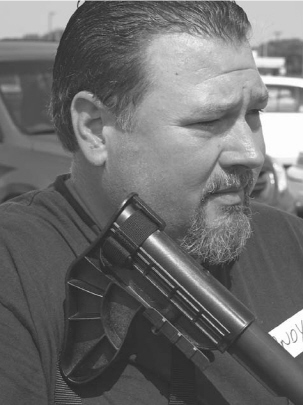
The Duostock pivots down onto your chest or vest.
In the beginning the AR was a light, handy carbine. The M-16 had a relatively short fixed stock. However, in a military rifle nothing can be allowed to go to waste. The hollow stock was soon redesigned with a trapdoor in the buttplate, and the enclosure was deemed large enough for a cleaning kit. Most “old” stocks you’ll see will be “A1” stocks, with a trapdoor.
In the 1980s, with the redesign of the M-16, the stock’s shortcomings were addressed. Basically, the old plastic formula was deemed too fragile. The new, A2 stock was made of tougher stuff. It was also lengthened by 5/8 of an inch. Why? When shot prone, the old stock was a bit short for tall troops. I find that I often have my cheek right against the carrying handle while shooting prone. If I’m not careful I’ll rap my glasses against the handle on each shot. Of course, not all troops are 6'4" tall. And in the military you can pretty much count on those shooting for real having web gear and body armor on, adding length of pull. But when shooting on the target range, in a shirt or jacket, the stocks were too short. So the A2 was lengthened. I even built a rifle for competition with yet-more length. Olympic Arms made (and still does) a stock filler that adds another inch to the length of pull. With that on, I never had the carry handle hit me while shooting.
However, making a rifle that is suitable for target competition is often counter-productive to combat. What the military has found is that the A2 stock is too long for lots of soldiers and Marines in lots of the situations they face. Trying to handle a 20" barreled, full stocked M-16A2 inside of a humvee or armored vehicle is very difficult. The Armed Forces have not decided to simply yank the A2 stocks off of every rifle. I imagine part of it is cost. It would cost a bunch of money to do so. But it is also, and curiously, a matter of markings. If a rifle is marked “M-16A2” it is defined as having certain characteristics. If you take a rifle marked M-16A2 and y ou rebuild it into the M4A1 configuration, it would work just fine. It would also confuse the heck out of the supply system. How do you note in the inventory system that a rifle marked “M-16A2” is actually a M-4A1 configuration? Every time someone does a count, they’d note it as an “A2” despite its sliding stock and stubby barrel. There isn’t room to over-strike and re-stamp the model designation. The bureaucratic mind simply boggles at the thought of exceptions. No, if the Army is going to switch over to an all-M4 weapons issue, they’ll stuff the M-16A2s in storage and buy new M4s.

Mil-spec buffer tubes (like this Vltor) run a nominal 1.150”. Non-mil-spec tubes run 1.170”. It can matter, as a mil-spec slider often won’t fit on a non mil-spec tube, and a non-mil-spec slider rattles like crazy on a mil-spec tube.
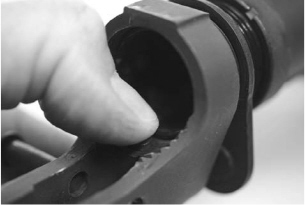
Use your thumb to hold the buffer retainer in place while you screw the buffer tube on.
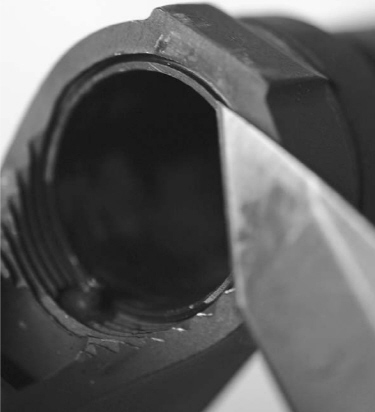
The top of the buffer tube on some telestocks might hit the upper as it hinges down. If so, you’ll have to file here to provide clearance.
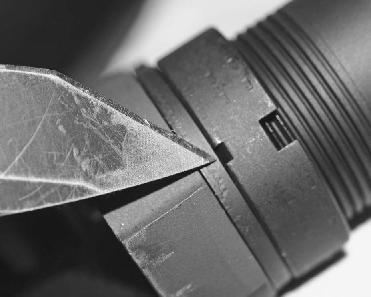
Small notches go towards the receiver so you can stake them later.
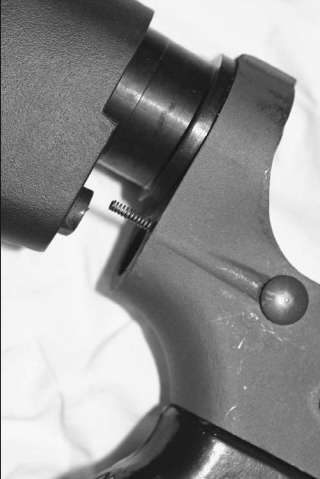
The rifle buffer tube screws in until its shoulder stops against the receiver.
The stock keeps the rear takedown pin spring in place.
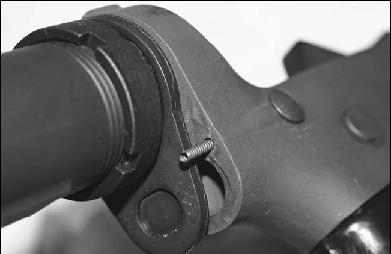
The telestock uses a rear plate to keep the spring in place. Tip the assembly slightly to one side to insert the plunger and spring.
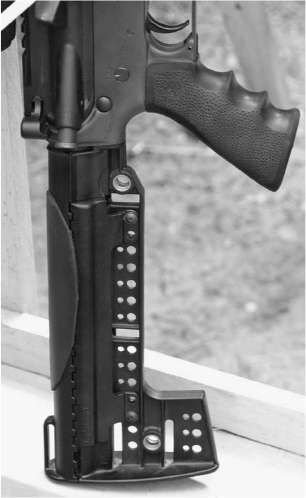
The Vltor rifle Modstock, this being the Clubfoot. Very solid and comfortable, with lots of battery storage space.
But I digress. When the stocks were changed from A1 to A2 the buffer tube was not. The tube is too short for the A2 interior, so the designers included a spacer. The spacer is simply a plastic or aluminum cylinder to fill the gap. Why couldn’t the new stocks be designed to fit without the spacer? Beats the heck out of me. For a long time, I wondered: why not spec a new tube for the new stock, one that is longer, with a built-in buffer spring (or add-on on the buffer weight) to dampen felt recoil? I finally found out recently. The plan was to make the new stock longer, and make an improved short-length stock as well. That way, short-statured troops could have an option. Well, as with so many good ideas, the government never got around to making improved A1-length stocks. (The government never met a good idea it couldn’t screw up.) Thus, all rifle-stock buffer tubes are the same. It doesn’t matter if you install an A1, and A2, or some other rifle stock, you’ll use the same buffer tube, spring and weight. You must not, however, get A1 and A2 stock screws mixed up. The A1 is the short one, A2 the long one. The A1 won’t reach if you’re trying to bolt on an A2 stock. If you use an A2 stock screw to bolt an A1 stock on, the screw is too long: it will stick into the buffer tube. There it can easily be struck by the buffer weight while cycling, and eventually bust the buffer tube.
Telestocks, however, are not all the same, nor do they ride on the same tubes.
Rifle Stocks
A1
The original A1 stocks had no trapdoor in the buttplate. I’ve seen a few, bolted to military surplus M16A1 rifles used by police departments. They are short, light, handy and a tad fragile by today’s standards. But they are entirely useable. And for someone building a retro rifle, necessary. The later A1 style has a trapdoor incorporated in the buttplate, with a hollow cavity inside the foam plastic for storage. It was just large enough to hold a cleaning kit. The stock was changed for the A2 upgrade, and you rarely see an A1 stock on a new rifle.
A2
In the early 1980s the military (mostly the Marines) wanted an improved M-16. The Army wasn’t so hot on it, as they were (and still are, to a certain extent) pinning their future on a new rifle that would leapfrog past the M-16. (They’re still waiting.) The A2 had a number of improvements, but the stock is our subject. The plastic formula was made stronger, the buttplate stronger, and the stock longer by 5/8". Great for target shooting. However, the extra length made the rifle tough to use for those bundled up in tactical gear. I’ve even seen short-statured officers in classes who were unable to use the rifle, the A2 stock was so long. How unable? From being unable to post a passing score on drills or the qual course, to shooting perfect scores, simply from changing the rifle from the A2 to a telestock.
If you are tall and long-armed, the A2 is fine. Otherwise, it is too much of a good thing. However, it is common, and you’ll often find a standard rifle with an A2 stock on it, so you’d best be familiar with it.
You can tell the A1 and A2 stocks apart by their length. The 5/8" difference is obvious. The buttplates are also different, the A2 being squarer on the edge than the A1. Once you’ve had a few seconds to compare them side-by-side you’ll be able to spot them afterwards.
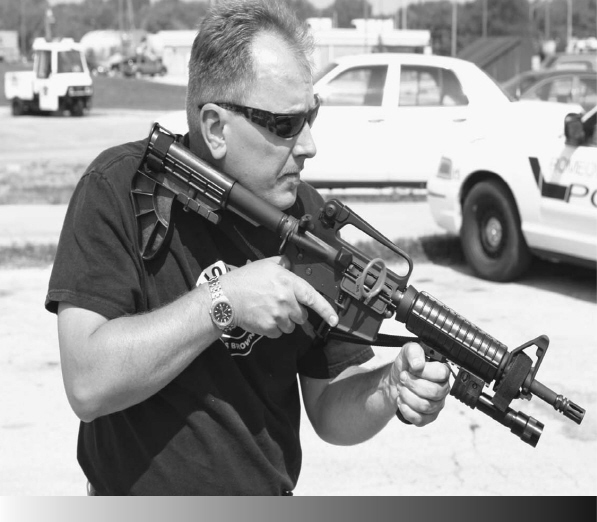
Compared to the old stock (CAR or M4) the Duostock keeps more of the stock in contact with you when the rifle is in low ready.
One addition I made to one of my ARs is the Olympic stock extension. Inserted between the stock and the receiver, it adds a full inch to the length of pull. I installed it on an A1 lower I have with an A1 stock on it. The length of pull comes out to an even fourteen inches. If I put an A2 stock on, it would be more than fourteen and a half inches. When I’m shooting prone, with iron sights, I need that much to keep the charging handle from going up my right nostril. Unless you’re tall and gangly, and plan to do prone shooting with iron sights, you probably won’t need a stock extension. But it exists if you do.
Rase
Rase makes a stock that they can truly call unique. In the modern usage, “unique” is often modified (as in “most unique,” not grammatically correct) or used simply to mean “interesting.” Rase takes a stock shell and installs a latch after cutting an access hole. The stock now holds a 20 or 30 round magazine. (You can have one or the other, not both, in one stock.) In use, you simply bring your support hand back, use the web of your hand to push the latch back, draw the magazine down, and then bring it forward to load.
The stock is an A2 shell, so if you have a problem with the length of the A2, you’re going to be in the same boat with the Rase. But if the A2 length isn’t a problem, then boy is this a useful stock. I suppose a careful gunsmith or craftsman could shorten the receiver end of the stock to bring it to A1 length. The Rase stock solves a few problems that other spare magazine methods have. First, it allows right or left-handed shooting, something the stock pouch doesn’t. The ammo is protected, which the dual-mag setups don’t. It doesn’t add weight, like the Redi-Mag. (I love the Redi-Mag, but it does add weight.) And you don’t have the bulk of the Rase stock creating storage problems, either in a vehicle rack or an armory rack. In use, you can swap magazines without lowering the rifle or removing your firing hand from the pistol grip.
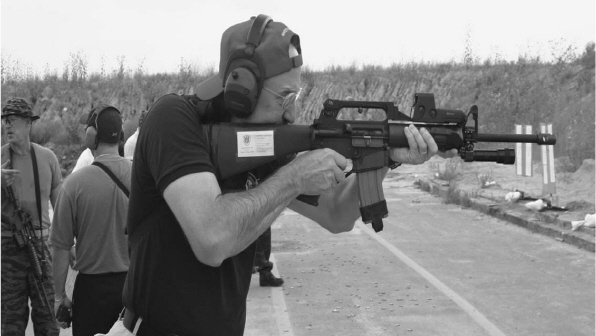
The A2 stock was meant for target shooting. On the range it keeps the sights out of your face. With body armor on, it makes the rifle too long.
Ace
Ace makes several stocks of interest. The fixed-length one that caught my eye is the Skelton stock, the ARFX. Basically, take an aluminum buttplate, and fabricate a support bar that goes from the buttplate to the spring retainer plate. (That’s like saying a Mercedes is a vehicle with a tire at each corner.) The buffer tube? A slip-on foam tube cushions it, protects your face and hearing from buffer spring “boing” and provides the lowest cheekweld possible. Comfortably, too. I should make it clear, however, that “slip-on” is used in the broadest possible sense. Wrestle-on is more like it. Of course, the time (and sweat) you’ll spend wrestling on the foam tube is nothing compared the years of non-slip use you’ll get once it’s in place. I like it. I like it a lot. If you want a comfortable stock while not giving up the length of a rifle A1 stock, then the Ace ARFX is for you. The ARFX has sling swivel attachment points fore and aft, and on both sides. Since it is aluminum, if the provided points aren’t enough it would be pretty simple to drill and tap sling points where you needed them.
Vltor Modstock
The Vltor riflestock is way cool. The Modstock comes in two lengths, A1 and A2. It also comes in two shapes, the standard and Clubfoot. Why the Clubfoot? In some shooting situations, especially using a bipod, you’ll want to use your non-shooting hand under the buttstock to support and locate the stock. You’ll shoot faster and more accurately that way. The Clubfoot gives you a place to put your hand, and to grasp the stock. The Vltor offers colors as well, and you can swap the compartments to gain battery storage space. The battery compartments also provide a first-class check weld, too.
CAA SRS
The sniper rifle stock will make your gear-buddies salivate. First, it looks aggressive. Second, everything is adjustable. The buttplate (rubber) can be moved up or down. The cheekpiece can be raised. The length of pull is adjustable, with nine different lengths. And there is the monopod. If you drop the pod straight down, you can adjust its length until the rifle stands on its own tripod. (Monopod and bipod on the forearm.) You can use the monopod as a left-hand holding fixture, either straight up and down or angled. The whole assemblage is composed of glass-filled polymer; tough, impervious to the elements, and not likely to freeze your face in cold weather. (A lot of stocks have the last advantage. Polymer does that for you, as opposed to aluminum.)
What is the downside? Weight and bulk. While not too much heavier than others, it can matter. However, if you’re already packing a heavy rifle, what are few ounces? And the balance of a nose-heavy rifle can be improved by adding weight in back. No, the stopper for some of you will be price. At an MSRP of $465.50, it is literally half the cost of a rifle. I don’t usually mention prices, as they are prone to change, and a lot of readers are relatively price-insensitive. But at twice the cost of the competition, the Command Arms SRS has some proving to do.
Magpul
The Magpul PRS (Precision Rifle/Sniper) stock is perfect for a sniper/DM rifle. You simply remove your regular rifle stock and bolt the PRS in its place. The cheekpiece is adjustable, as is the length of pull. On the bottom the lower cover comes off, exposing a rail for a monopod. The sling attachments are bolted securely to the stock, so you need not worry about your sling attachments coming loose. At 28 ounces it is a bit portly, but no more so than other stocks with adjustments. You can well exceed its weight by going with a target version adjustable stock, something seen on the High Power firing lines. For the restrained tactical look (and a lot of performance) the PRS is the stock of choice of a lot of AR shooters.
Z-M Folder
The Zitta folding stock is in a separate class from the other AR stocks. In order to have a folding stock, you have to put the buffer, spring and other parts someplace else. You also have to shorten the bolt carrier. The carrier recoils into the buffer tube. If you don’t shorten the carrier, it will recoil out the back of the receiver. So, in order to install a folder you have to do a whole lot of other engineering, too. On an AK, switching from a fixed to a folder is work, but not like on the scale of an AR switch. In the AK you grind the rivet head off, drill or mill the rivets clear of the receiver, and remove the rear stock trunnion. (In certain models it isn’t possible at all, but the particular details are for another book.) In the AR, you’re in for a lot more engineering. However, one application lets you put a folder on your AR relatively easily: a .22LR conversion. There, the bolt doesn’t recoil into the buffer tube. You can have an über-cool folding stock on your AR if you make it into a dedicated .22LR.
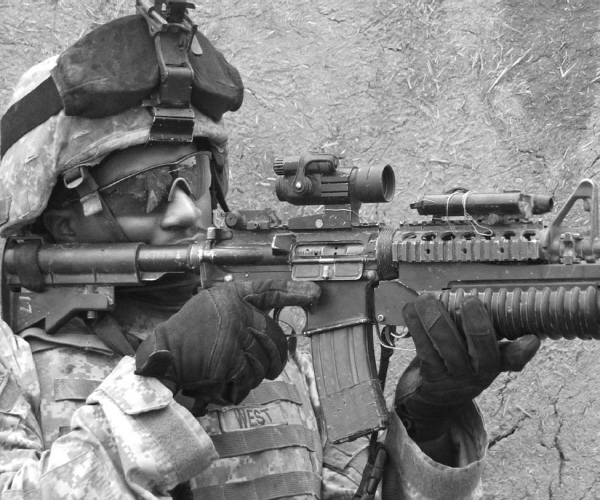
Here you see the “bazooka hold,” or upright stance. Sgt. Adrian West, from the 172nd Stryker Brigade Combat Team, aims at a possible threat during house-to-house searches in Mosul, Iraq. Photo by Staff Sgt. James L. Harper Jr.
Telestocks, or Really, Really CDI
The original telestocks came about from the XM-177 and XM-711A1 of Vietnam. As light and handy as the M-16 and M-16A1 were, they were not as compact as smaller rifles and carbines. The M1 Carbine, for example, was smaller, especially if it was in the paratrooper stock. Submachineguns were smaller. In an effort to make the M-16 as compact as possible, the barrel was shortened and the stock changed to the telestock. The stock slides in and out on the buffer tube, changing length. Original stocks had two positions, open and closed. Since then the makers have been trying to one-up each other, and there are now more length options. You can now have stocks with two, four, five, six and even seven positions. Is more better? Some think so. The ability to make the stock “just right” when you have shooters of different sizes and varying amounts of gear on, matters to some. I guess I’ve spent so much time accommodating myself to a few choices that it doesn’t matter so much to me. The whole point of the stock is to make the rifle/carbine compact in storage. As soon as your hands grab it, you should extend the stock. What matters more to me is that you can make any telestock too short. In its fully-contracted position, the stock will not prevent your face from striking the charging handle before your shoulder hits the stock. It is important to limit the forward travel of the stock, so it can’t be collapsed to the relatively unsafe shortest position.
Early sliders were aluminum, and painted a glossy black or coated with a plastic composition. Those who are particular will make sure they paint the stock of their XM-177 clones the same black. Later, I think in part to reduce costs, the slider was changed to plastic. It was also lighter. The lightest carbine you can make would be one with a pencil-barrel and a plastic slider on a telestock. The original design also had a sling loop on the top of the slider.
One change in the M4 program was to alter the slider again. The stock had the hollows under the sides of the tube filled for a better cheek weld. The loop on top for a sling was removed. Apparently that loop broke off in extreme cold, or when too much force was applied. I’ve seen museum M-16s and XM-177s with the loop broken. I wish instead of simply removing the loop, designers had figured out a way to reinforce it. I find it very useful. The new M4 style telestock sliders let the rear sling attachment slip off the tube. I guess shooters starting with it aren’t bothered by it, but I find it annoying.
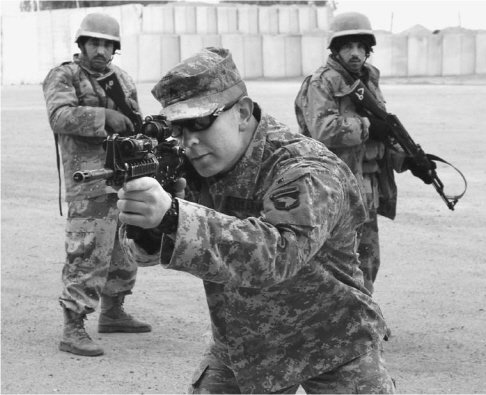
The AR (in this instance an M4) is light, handy, fast to use and doesn’t recoil much. Sgt.Mathew Hall, from the 101st Airborne Division, demonstrates a shooting stance to troops from the 4th Iraqi Army Division at Forward Operating Base Summerall. Photo by Spc. Charles W. Gill.
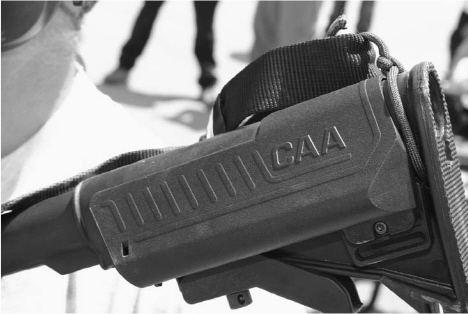
The CAA Saddle gives you a better cheek weld and battery storage for a mere twenty bucks.
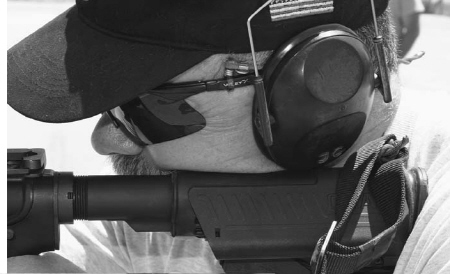
Here you see the cheekweld.Why everyone doesn’t own one of these, I don’t know.
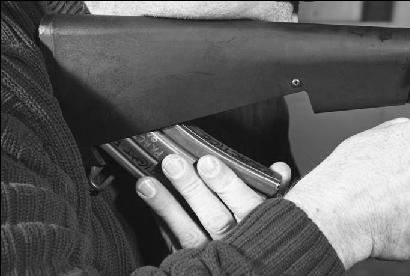
The Rase stock is slick and handy. It is restricted to one or the other: 20 or 30 rounds.You can’t have both.
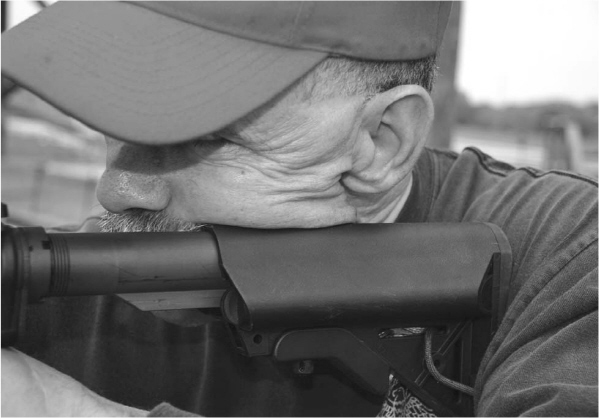
The LMT SOCOM stock is a great stock for cheekweld, and there is no wobble when you’re aiming.
The big thing you have to know about buffer tubes for telestocks is that there are two sizes: mil-spec and everything else. To understand why, you have to know how they are made. Starting with a forged aluminum bar (mil-spec) or billet (not mil-spec but entirely suitable if done right) the manufacturer bores out the tube. The outside is then profiled. On a rifle buffer tube the entire set of operations can be done on a CNC lathe, at high speed. The rifle buffer tubes practically fall out of the machine. For the telestock buffer tube, the sides of the tube have to be milled. In the old days that was done on a horizontal mill, with curved cutters profiling the tube. Now they are cut in a CNC lathe/mill combo, with the tubes bored and the sides profiled. The threads then get cut, and the finish machine operations for mil-spec tubes bring the tube down to a diameter less than that of the tops of the threads.
In the non mil-spec tubes the outside of the tubes are profiled, and the threads are cut. The tubes are not re-profiled, and the exterior diameter of the non mil-spec tube is the same as the exterior diameter of the thread tops. As a result, a slider made to fit a non mil-spec tube will rattle like mad (and may not even lock in place) when placed in a mil-spec tube. And a mil-spec slider might not even fit onto a non mil-spec tube.
Why not do it the mil-spec way? Two reasons, both cost-related. One, forgings cost more than billet. Second, by eliminating machining steps you cut manufacturing time, cost, tool wear and machine wear. A re-pass to profile the tube may not seem like much, but when you’re going to be making thousands of tubes it adds up.
How do you know which tube you have? You could measure it. The diameter is enough to show up with dial calipers. Mil-spec tubes will have a nominal diameter of 1.150”, while the non-mil-spec tubes will be 1.170” or so. You can simply look. Is the tube diameter the same as that of the threads? Or is the tube stepped down from the threads? Or you could be careful who you buy from. Colt makes mil-spec (obviously) as do several other vendors; Stag Arms/CMT, Lewis Machine & Tool, Vltor. If someone makes a mil-spec tube they usually aren’t bashful about mentioning it. Where you might get into trouble is at a gun show. Standing in the aisle, the dealer may assure you that his stock is mil-spec. He may be right. But be careful.
CAR
The original, either made of plastic (sometimes called “Fiberite”) or aluminum. The CAR stock is relatively smooth, with a rectangular loop on the top rear. The loop was to keep a sling in place. Unfortunately many rig the sling directly to the loop, without running it around the slider tube. Rigged that way it can break. (It takes a bunch of effort, but you can do it.) As the original, you’ll see a lot of them on older rifles, or rifles built as retro clones. The stock works, but is a little “old school” for someone looking to build an M4 clone. However, they are perfect for an XM177 clone, or an old-school Colt SBR build like the Model 639 or 733 series.
The original XM177 stocks were coated with a glossy black plastic. Later ones were a matte black plastic. So if you really are trying to do a period-correct “shortie” you’d better be sure exactly which it is. Then again, Colt was well-known back then for making orders out of whatever was on hand. A department could order a bunch of short-barreled rifles and get a mix of A1 and A2 lowers, with parts from the previous decade’s production runs.
If we ever get the Federal law changed and can buy new machineguns again, collecting Colt select-fire rifles and carbines and their variants would be enough to make your head spin.
M4
When the carbine idea for the M16 was revived by Colt, the stock got “improved.” One change was to adjust the formulation of the plastic involved. The new mix is a lot tougher than the old. I guess that matters to some, but as I’ve never broken a plastic CAR stock (had to knarf an aluminum one once, though) the new mix doesn’t matter to me. What they did change was to drop the top sling loop and add stiffening ribs under the slider tube. I think they also wanted to add material in the space under the tube for additional support for your cheek weld, but I can’t tell that there is any there. The checkering on some production stocks is more aggressive than it was on the old CAR stocks, but not on all.

The CAR stock has a sling swivel loop on top.
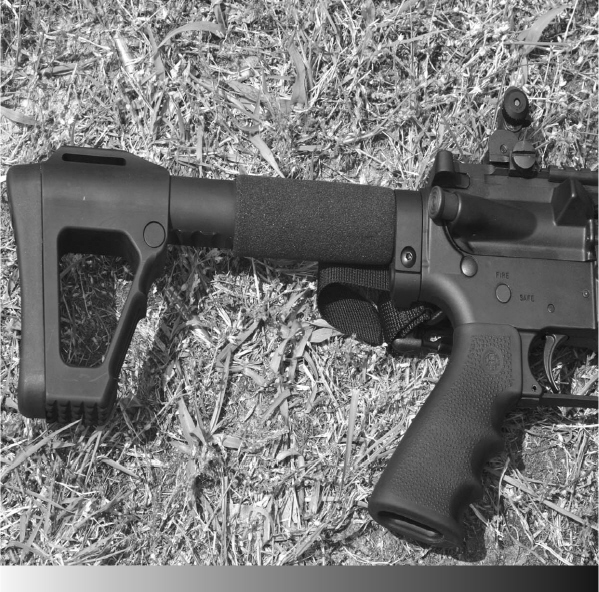
The Ace Ltd. SOCOM stock is durable and the foam makes shooting easier.
The stock is not a bad one, just something I have to get used to. The lack of a top loop means slings slide off when you sling the rifle. Apparently this doesn’t bother anyone who started on an M4 stock, and it is only old farts like me who started with CAR stocks who object.
Ace, Ltd.
Ace also makes adjustable stocks. Their improved M4 stock, the M4-7 offers options others don’t: the buffer tube is reinforced. The stock has seven positions. You can use the locking bolt to stop the stock at predetermined locations, making it only as long as you want, or preventing too-short sliding, thus keeping your face off the rear sight. The tube is marked so you can easily tell what length you have it opened (or closed) to. The Ace M4-7 is a definite improvement over the current M4 stock.
The ACE M4 SOCOM only has four positions and doesn’t offer them over the range of lengths the M4 does, but there are other improvements. The tube is stronger, less likely to bend. It also has the foam covering of the ARFX. The buttplate is more like a shovel handle, so you can easily grasp it in odd positions. And the SOCOM comers with a singlepoint sling attachment locations. The SOCOM also has the advantage (a real one in some circles) of not looking like the M4 stock. It looks better to some eyes. (I’m still trying to figure out if I like the look or not.)
Vltor
Pronounced “Ul-tor” their Modstocks stocks are solid and comfortable, and give you options on configuration. You can install the battery compartments or not, your choice. You can have them in black, green or brown. Oops, excuse me: Black, “Foliage Green” or “Flat Dark Earth.” Good luck finding either foliage or earth to match, courtesy DoD. I wonder if the person who named those colors worked for a while in the paper industry. You’d be surprised how many different names paper makers can have for something as simple as off-white.
Vltor buffer tubes only come in mil-spec diameter. If you have a non-spec buffer tube you can’t just slide the Vltor stock on. The battery compartments are user-changeable. If you want them, great. If not, you can take them off and replace them with filler panels that keep the locking edges from rubbing on your face. Replacement is simple: you just undo the locking screws that keep the compartments or filler in place, pull off and replace, then bolt down. You can even put one compartment on for a cheekweld (for which the Vltor is very comfortable) and leave the other side standard. You could, with a little fussing, put the battery compartment on the shooting side, and attach a magazine pouch on the other side. Me, I’m not a great fan of the pouches, but I see them on half the rifles in Iraq (or so it seems from photos) and a lot of shooters do like them.
As I mentioned, the Vltor stocks are mil-spec tube diameter. If you want to install the Vltor but your rifle has a non mil-spec tube, you’ll have to change tubes. You can get a complete kit from Vltor. At the present kit cost, the tube, buffer and spring add $40 to the cost of “just the stock.” You might (maybe, barely) be able to find a mil-spec tube, spring and buffer for $40 at a gun show. It will probably be used, not new. More likely it will cost you that much just for a tube. Now, if you already have a telestock on your carbine, and want only to add the Vltor stock, it may seem excessive to buy tube, buffer and spring. But, the chances of finding what you need at the cost Vltor is charging, and it fitting, are slim. If you have a non mil-spec telestock, just get the whole Vltor kit, and save yourself potential hassle. Those of you changing an A1 or A2 rifle stock to the Vltor will have an easy choice: just get the kit, and install it.
Duostock
We all tend to think of our experience as being definitive. One example (if you’ll allow me a slight digression) is easy to demonstrate: think about the TV shows you watch. Now, consider the actors. Compared to your height, how tall to you consider them to be when watching? If you’re like most people, you have this gut feeling that they are the same height you are. So, when you go and shoot, you consider the shooting you do to be representative, and the stances you develop, normal.

The Magpul PRS is an adjustable tactical marksman stock.
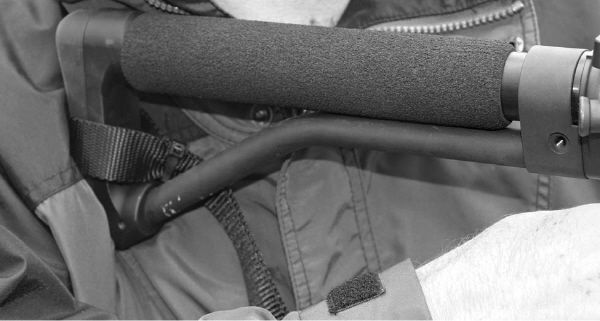
The Ace Ltd. ARFX stock. Solid, comfortable and minimal.
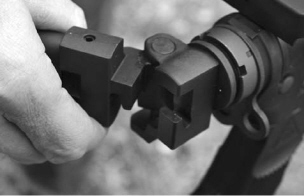
The Z-M folding stock. The hinge is very much like that of the Galil. (Another reason to go to a shooting school, to learn more than just what you’ve developed.)
In the military, you may be looking at a location, ready to shoot in moments, for a long time. Hours. All day. A regular shooting stance might not cut it. Another influence is the Marine Corps. Offhand qualification shooting calls for a very upright stance. The idea is to use bones for support instead of muscles. Muscles get tired, but bones don’t. As a result, the rifle offhand stance for many shooters (and a lot of instructors) is to have the top half of the buttplate visible above your shoulder, when viewed from behind. In some circles this is known as the “bazooka hold.”
The Duostock is molded to provide additional support when in that position. Additionally, it also provides a rotational surface, so you can swing up from low ready. A low ready where the rifle was actually supported, and not as if the toe of the stock was nailed to your chest or vest. Many shooters love it. As I have mentioned before (probably too many times) I started back in the really old days. When I started shooting ARs, there were still guys healing from when their M-16 failed them. I learned to lock the stock low and tight, and then sort of hunch forward on the stock. So the first time I tried the Duostock, it was a “What’s the big deal?” experience for me. Then I forced myself to use the high hold, and darned if it didn’t work exactly as described. Those who had never used my “chiropractor hold” (as one student has described it) find the Duostock is really, really good. My suggestion is that you should hunt down a rifle equipped with a Duostock and try it. If you like it, then get one for yourself. If for you it is the same “what’s the big deal?” experience it was for me, then don’t get it. I’m not getting any kickbacks, and Tom at Duostock won’t have his feelings hurt.
The Duostock comes only in black, and currently only in mil-spec tube size. However, the plastic formula of the Duostock takes paint very well (it should, there are a bunch over in the Sandbox that have been painted there) and mil-spec tubes aren’t that hard to find.
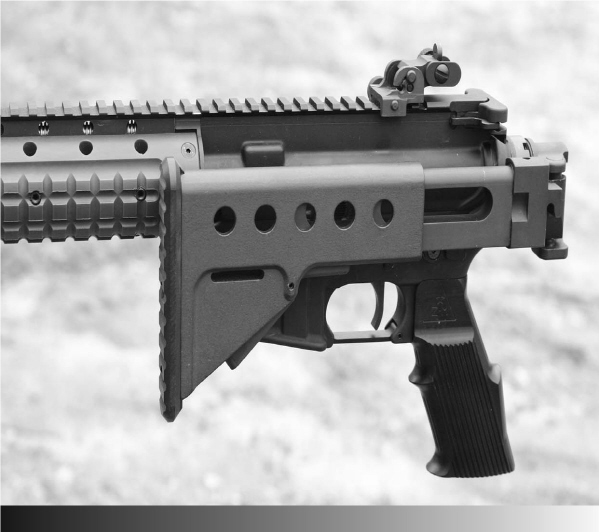
You can see that, folded, the Z-M stock provides no location for the buffer and spring.
SOCOM
The collection of services and personnel known as Special Operations managed a neat trick: they got independent budget authority for a lot of their gear and training. So, they can get gear directly, and spec it to their needs, without going through the labyrinthine acquisition process of Big Army. One program was to get what they needed for their rifles. The carbine got, among other things, a new stock. The SOPMOD stock is made solely by Lewis Machine & Tool for the US military, and you can get it either as a stock, a complete stock and buffer tube assembly, or already installed on an assembled lower or complete rifle. As a military item, it comes as you’d expect, mil-spec tube diameter only. Let me clarify that: LMT is the sole provider of the SOPMOD to the government. No others who make a clone SOPMOD provide them to the government. You can buy it; you just might have to wait a while if the government has just sucked up LMT’s production for the next six months or so.
The wedge shape gives you battery storage compartments and a solid cheekweld. Unlike the Vltor, the compartments are not changeable. Also, you can have the SOPMOD in any color you want, as long as it is black. One thing those who love the LMT SOPMOD gush over is the solidity of the stock. Most stocks wobble. Or so I’ve been told, as I’ve never noticed wobble while shooting. The SOPMOD stock rides smoothly, has no play, and locks tightly in each of its six positions. Other stocks have some play. If that bothers you, then I guess you’ll only be buying LMT SOPMOD. If not, you have choices.
I find the size and angle of the wedge of the LMT SOPMOD to be very comfortable. My face is not weaving around behind the sights, looking for the irons or the reticle. In that regard, I find all the “wedge” stocks to be the same. The SOPMOD is on par with the rest for shootability. It gains extra CDI points for being real current GI gear.
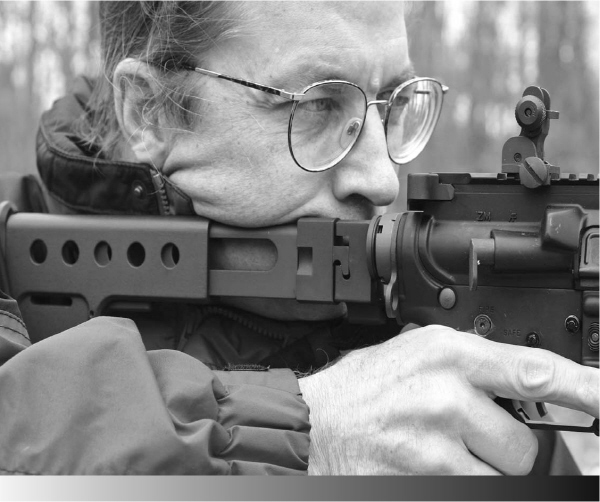
The Z-M stock is comfortable and adjustable.
J&T
J&T Distributing took the basic M4 stock, and upgraded a bunch of things. They went over the buttplate, the latch and the nut that holds the latch, and radiused all the sharp edges. It may not seem like much, but after a few months of living with a sharp-edged stock, you’ll find your gear (and hand) abraded. The radiused edges also keep it from catching and hanging-up on your gear. They added material around the latch pin bore on the stock, so you’re unlikely to bust the stock at that point. Inside the slider, they changed the shape to include four flat panels, so the slider rides on the panels on the tube, instead of rattling around on the tube. That’s tighter and offers room for gunk to get out.
One detail they didn’t alter (or did, depending on your viewpoint) is that the buffer tube diameter is still non mil-spec. However, the J&T stock is durable enough to be unlikely to break. The slider is made of Nylon 66 with a high fiberglass composition. The buffer tube is 7075-T6, unlike a lot of non mil-spec tubes that are made of 6066 or other 60-series alloys.
It is tough, works great, and if you want an M4 stock this one should be high on your list. If you’re planning on upgrading to an Vltor or LMT SOPMOD in the future, then why stop at an M4 on the way? Better yet, if you want an M4 now, and want something more in the future, then get the J&T, and add a CAA Saddle in the future. J&T is also known as Doublestar. You may recall them from my first book. They make solid, dependable gear. Your buddies may razz you for not having bought “used by Special Forces” gear, or something not made by the “ABC” consortium. But with the money you’ve saved, the practice ammo you bought will serve you in good stead. Buy the J&T, install a CAA Saddle, then buy lots of practice ammo with the savings. Practice, kick their butts, and tell them who told you to do it.
CAA Saddle
Not everyone wants to spend a lot of money on a new stock. Some shooters simply can’t stand the thought of having something less than what is deemed “the best” or what the guys out in the front are using. That’s fine. However, the choice is not always between “what SF uses” and “crap.” The Command Arms Saddle is something inexpensive that is worth a lot. The basic unit is a moulded cover and battery compartments that fit over and around your slider. The only drawback is the installation. It requires fussing, three hands, and the help of your buddies. It uses small screws and nuts that for best security should be loc-tited in place. But once it is in place, you get a much better cheek weld, something quite close to offered by the high-end stocks. There is even room to secure 550 cord around your slider as a sling location, if you don’t like the locations the Command Arms Saddle provides. One way is to loop the ends of a 14" to 16" length of 550 cord through the bottom sling swivel, then lash it up over the top of the stock. There, you can either attach a sling end, or tie the cord in another loop to provide an attachment point. We took another path: we drilled a hole through the stock flat, behind the Saddle but below the buffer tube tunnel. Then we tied 550 cord passed through the hole, above the slider, and looped it for a sling attachment location.
In the course of testing, Jeff Chudwin, Ned Christiansen and I wrestled one onto a carbine that Jeff was rebuilding. I say “wrestle” only because it took all three of us to hold the rifle, stock, plates and bolts all at once, while we tightened everything. We quickly figured that a drop of superglue to hold the nuts in place made things go a lot easier. Once installed, we agreed (and the targets the next day confirmed) that the stock was much more comfortable than a bare M4 would be, and getting a solid and consistent cheekweld was a lot faster.
The Saddle falls into that category we all search for: good, cheap gear. At a mere $20, the savings between the high-end stocks (which I love, but I’ve got to tell the truth here) and the Sidesaddle are enough to buy you a bunch of practice ammo. As I’ve pointed out before, getting good-enough gear, and spending the rest of your money on practice ammo, is going to build skills a lot faster than spending all your money on the top-end gear. It does not fit on a CAR stock. The top loop of the CAR stock interferes with the Saddle. I imagine you could trim a slot in the Saddle to clear the loop. While you’re rigging your Saddle, don’t forget to tie a cord or cords to your battery caps, so you won’t lose them.
CAA CBS
The Command Arms replacement slider is improved over standard ones in several ways. First, the buttplate has a rubber covering, a thick covering. Not that the recoil of the AR is so ferocious that you need a recoil pad, but it does provide a no-slip surface. There is also a battery compartment, with a twist. Instead of tubes, it is a lateral compartment that holds four Lithium 123 batteries. You also have quick-detach sling sockets, and the offside of the stock can hold the Command Arms spare magazine holder. A solid and comfortable slider, even if it didn’t have the battery compartment. The CBS is a non-mil-spec diameter tube slider.
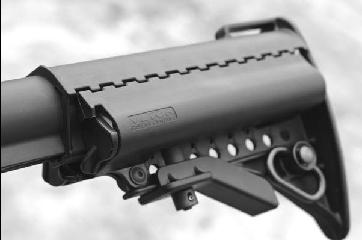
The Vltor stock offers battery storage, very neat especially if you find the shape better for a cheekweld. (I do.)
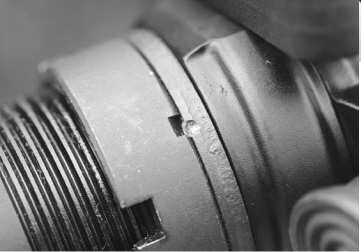
Here we see a properly-staked castle nut.
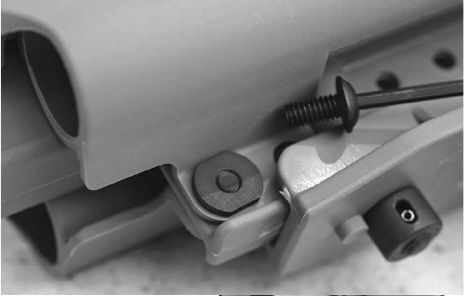
The new battery compartments use a pair of locking screws to hold them in place.
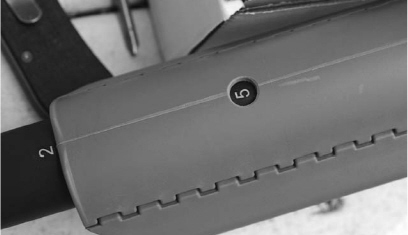
Vltor tubes are numbered on top, and the stock has witness holes.
DPMS Pardus
Latin for Panther, the Pardus is an improved M4 stock. First, the material is improved, a fiberglass-reinforced polymer. (Zytel, to be exact.) Second, the latch area is reinforced. No more busted stocks at the latch tunnel. Third, there are four sling slots on the Pardus in addition to the bottom sling loop: the standard two at top and bottom and on the buttplate, giving you side-mount attachment points. (An idea long overdue.) The buttplate is curved, given a sawtooth face, and best of all, the cheekrest area of the Pardus stock is widened so there is more support for your face. In all, good and needed improvements. The ergonomic latch is also listed as a benefit, but since I’ve never had a problem with the old latch, that’s one of those “Nice, but I didn’t need it” things. I’m not sure you can harm the Pardus with a ball-peen hammer. The Pardus is available just as a stock, or as a complete kit. The Pardus is for non-mil-spec diameter tubes. I installed one on one of my “test mule” rifle and found it to be quite comfortable. The ergonomic latch may be more comfortable, but what I noticed was how certain in latching and how smooth in use it was.
Choate
Choate has been in the firearms accessory business for a long time. They were not new when I first came across them over twenty years ago. The big product they made that had everyone excited back then was shotgun magazine extension tubes. Yes, they are common now, but twenty years ago they were hot stuff. Now Choate makes a lot more than just mag tubes. One is their version of the SOCOM. Typically from Choate you get a lot of value for the money, and their stock does not endanger that reputation. The slider is triangular, for good check weld. The latch solid. The buttplate rubber-coated for a non-slip grip. There are a pair of battery compartments. The extension tube (you can get just the stock, or tube and stock) has five positions. The stock has three sling locations.
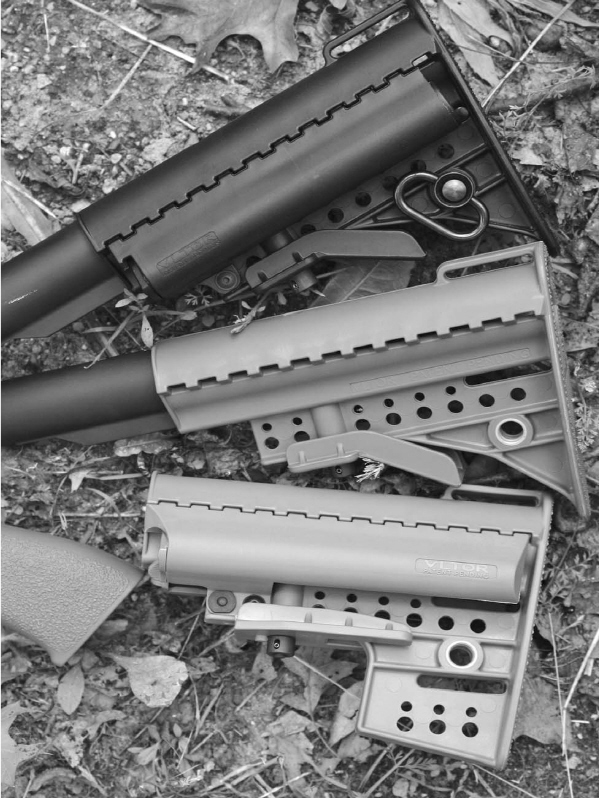
Top to bottom: Black, Foliage Green, Flat Dark Earth. (I guess the Army didn’t want to call the middle color “Sage Green,”which the Air Force has been doing for decades.)

Mil-spec buffer tubes will have the last few threads flattened by the profiling operation.
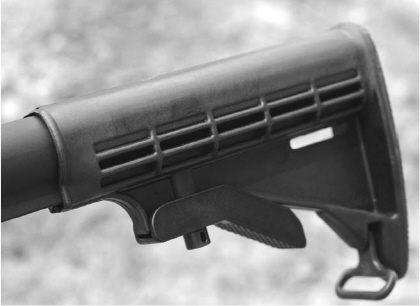
The M4 stock lacks a top sling loop, and has reinforcements on the underside of the cheekrest area.
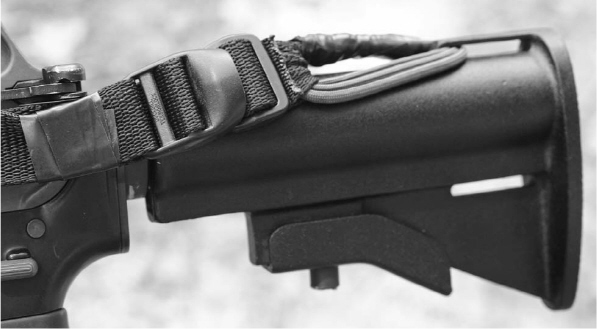
With several loops of 550 cord through the stock, you can then attach a sling to the loops.
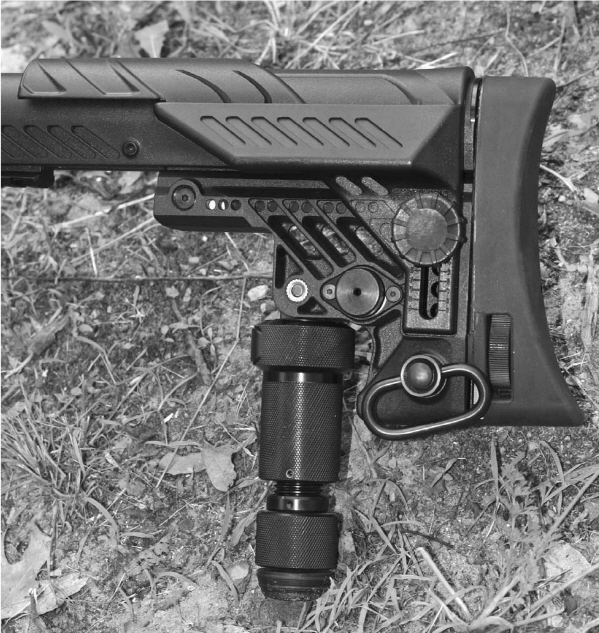
The CAA SRS. Adjustable in three locations, with a monopod for stock support.
There are differences, reflecting the fact that you’re paying half or less than an LMT SOCOM stock. The buffer tube in the kit is a non mil-spec diameter. The battery compartments only have metal threads in the front section. However, given the Choate penchant for making things stout, I doubt you’ll ever have the inserts loosen, let alone fall out. The caps do not have a way of tying them to the stock, so if you drop it you’ve likely lost it. And the stock is not tight to the tube like the SOCOM. Unlike the Vltor, the Choate (and to be fair, the SOCOM) doesn’t have the option of removing the battery compartments.
But for half the money, it is a hell of a deal. I tried the Choate stock in the kit on several other non mil-spec buffer tubes, and it did not fit them. Not surprising, as it is always a roll of the dice swapping things on non mil-spec tubes. So if you want a good fit, spend the extra money for a stock and buffer tube. The Choate stock by itself is listed as fitting the Colt buffer tube. Yes, Choate makes the sliders in two different sizes, so you can get a Choate for your Colt. If you are going from a fixed stock to a telestock, and aren’t worried about mil-spec tubes or not (half my telestock ARs have non mil-spec tubes on them), then you won’t be sorry with Choate.
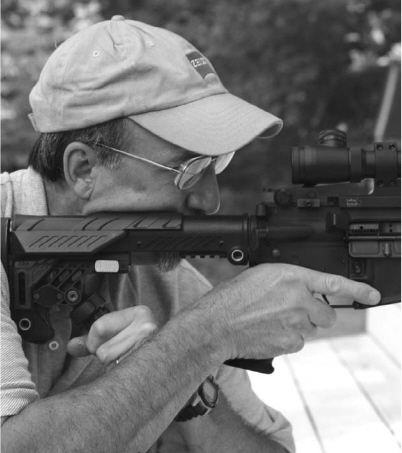
Here you can see how to use the monopod as a rear gripping location.
Stock Work
Installing stocks is easy. Before we begin, first you have to understand a few things that the AR stocks do besides give your shoulder a nudge. The stock rides on the buffer tube. Inside the tube, the buffer weight and spring provide the action function to push the bolt and carrier back after each shot. If you install the buffer tube incorrectly, the rifle probably won’t work at all. So it is tough to get in trouble on that score. But you can screw up a few other things. The buffer tube screws into the rear of the receiver. In the receiver threads is a hole, with a spring and plunger in them. That is your buffer retainer. Without that, your buffer would be launched across the room every time you took the upper and lower apart. In an emergency you can run the rifle without those parts. You just have to be very careful taking it apart.
Underneath the buffer tube, on the outside rear of the receiver, is the takedown pin plunger and spring. The spring pushes the plunger against the rear takedown pin, keeping that pin from falling out of the rifle. This spring/ plunger combo is kept in place by one of two things: the stock itself on an A1 or A2 rifle, or the rear receiver plate on a telestock assembly. When you take the stock of a rifle off, you risk losing the spring and plunger.
I have seen rifles modified so the spring and plunger are retained by a small Allen screw. Nice idea, but I’m not sure I want to be wedded to yet another small Allen wrench just to work on the AR.
When you install a stock, either type, you have to make sure the springs and plungers in the rear are correctly captured, or function will suffer.
Installing Rifle Stocks
Let’s start as if you were assembling a bare receiver. Insert a buffer retainer spring and the buffer retainer into the hole in the threads. Insert the buffer tube in the rear of the receiver and begin screwing it into place. Once the buffer tube leading edge gets close to the buffer retainer, push the buffer retainer down with your thumb. Continue screwing the buffer tube into the receiver. The buffer tube should stop against the rear face of the receiver, without binding on the retainer. If the tube stops but does not capture the retainer, or the tube binds against the retainer and holds it down so it cannot keep the buffer in place, something is wrong. Either the tube is machined wrong, the receiver is machined wrong, or the retainer hole is in the wrong place. In 25 years of AR gunsmithing, I’ve seen this once. The receiver was a POS, made in someone’s machine shop back in the early 1980s during one of the earlier assault weapons bans, and nothing on it was right. The chances of a new receiver being like this are so small that it is probably the tube that is at fault. The buffer tube on the rifle does not need to be heavily torqued in place. Wring it on hand tight. Take the receiver and push the rear takedown pin in place. It is the shorter of the two, and the one lacking a flat on the pin head. Then, slide a plunger into the retainer hole and follow it with a spring. Now stand the receiver on its front, and slide your rifle stock over the tube. (If you’re using an A1, make sure you’re using a short screw; if an A2, long screw and tube spacer.) Ease the stock down until it compresses the spring, then install and tighten the screw.
Rifle buttstock screws must have a thread-locking compound on them. It should have a patch of red or blue goo on the threads. The screw also must have a hole the length of it, through the center. The thread-locking compound keeps the screw from loosening, and the hole allows water to drain out. Tighten firmly and you’re done.
Telestocks are different. First, the buffer tube of the stock does not have a stop shoulder. It is entirely possible to turn the buffer tube in too far, bind the retainer, and cause yourself problems. Or not turn it in far enough and cause other problems. Also, the buffer tube has a retaining plate and castle nut to hold it on and the takedown pin spring in place.
Assembly is a bit more complicated. First, take the plate and nut off the tube, and the slide as well. The nut and plate are often shipped screwed on incorrectly. And the slider will just get in the way for now. Take the castle nut (so called because of the slots cut in the ends, like the crenellations of a castle wall) and screw it onto the buffer tube. Install it with the large slots towards the butt and the small slots towards the open end of the tube. Some buffer tube nuts will not have slots. The older-style buffer tube nuts have circular holes drilled through them as the wrench latches. They can go on either way. Screw it all the way down. Now slide the retaining plate on. Notice that the hole on the plate has a tab. The tab lines up with the groove milled into the threads of the tube, on the bottom of the tube. Also, the plate will have a bulge stamped into it. The bulge goes towards the receiver. With the nut and plate on the tube, start screwing the buffer tube into the receiver.
Once the tube gets close to the buffer retainer hole, install the spring and retainer. Hold them down with your thumb, and screw the buffer tube until it traps the retainer. You’ll have to pick a spot where the buffer tube is correctly lined up (locking tab spine down) and the retainer is held in place. Too far and the retainer is trapped. Not far enough, and the retainer comes loose. In a worst-case scenario you’ll have to file the forward end of the buffer tube to get the tube lined up and the retainer working properly.
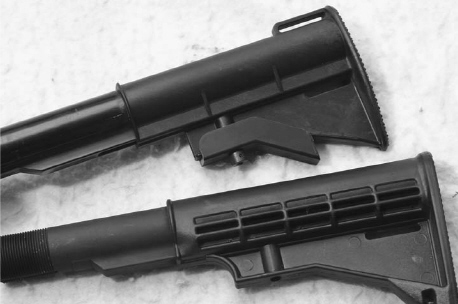
Top, a CAR stock. Below, a post-ban non-adjustable faux M4. During the ban, lots of rifles got pinned “M4” stocks. To replace them, just swap out the stock and buffer tube. Don’t bother trying to salvage the tube.
Before you go further, you have another alignment check to make. Take your upper and catch it in the front pivot pin, as in reassembly. Then carefully attempt to hinge the upper and lower closed. New-production mil-spec buffer tubes will have the upper half of the buffer tube lip machined away by half a thread, to provide clearance for the upper. Again, in a worst-case scenario you’ll have to file clearance on the upper half of the tube for the upper receiver, while keeping the retaining plunger properly trapped.
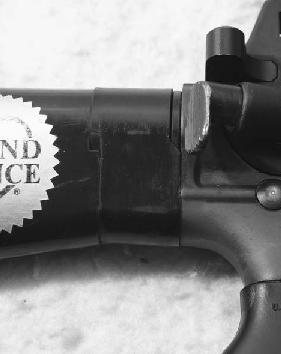
This Olympic spacer adds an inch to the length of pull. Not needed for tactical use, but mighty handy on the target range.
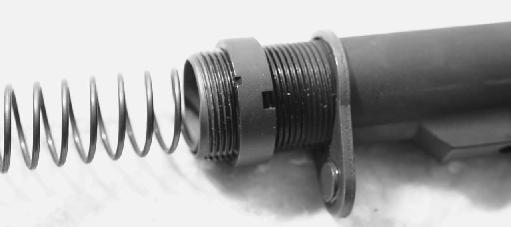
Telestocks are commonly shipped with the plate assembled wrong, just to keep it from getting lost. The plate goes between the castle nut and the receiver.
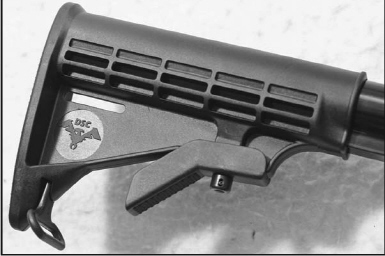
The J&T M4 stock offers improvements over others and is a solid stock that will give you years of service.
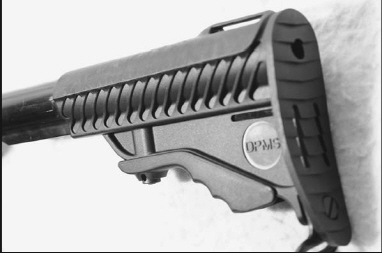
The DPMS Pardus is a solid stock with smooth operation, I particularly like the sling slots on the buttplate.
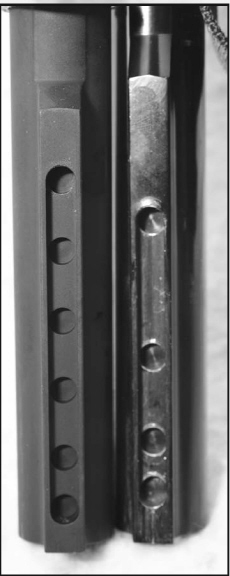
The telestock comes in a number of length versions, limited by the location holes milled in the spine. Left, six; right, four.
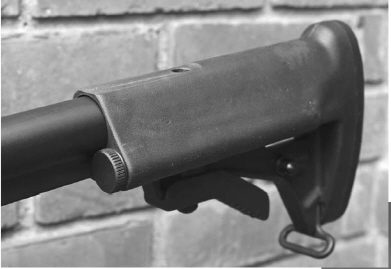
Choate makes solid, dependable gear. Notice on the top of the stock where it has been flattened, to clear the charging handle. Nice touch.
Once you have the tube lined up and the retainer properly positioned (in a bad-tolerance stock you’ll have installed and removed the tube a half-dozen times to file and fit), turn the tube just enough to let you get the rear takedown pin plunger and spring in the receiver. Then turn the tube back to where it was and press the plate forward. Hold the plate in place while you turn the castle nut down to lock the plate in place. With everything in place, once again check alignment, function and position. You need now to secure the nut. Hold your receiver flat on a bench or sturdy table, with a towel under it. Lean down on the receiver and use your buffer tube wrench to tighten the nut. You may be tempted to try and lock it in a vise. This would be a bad thing. Yes, you can “really tighten” the nut. You can also twist or break the receiver. You’ll also be tempted to simply hose the nut and threads with Loctite. (I know. I was in the old days.) Instead, tighten the nut as much as you can with the wrench and the bench. Then take a staking tool or spring-loaded marker, and stake the rear retaining plate into the small slot of the castle nut. That’s the proper mil-spec method. The only times I use Loctite is when I run into a hard retaining plate. Some of them are made quite hard. Usually they are the singlepoint sling attachment plates, and the makers want them hard so they won’t bend when hit. Hard means you can’t stake them.

You can clearly see the hole for the buffer retainer and spring. The forward lip of the buffer tube will trap the retainer but allow it to rise high enough to stop the buffer.
Some manufacturers are using Loctite to secure the castle nut. While it works, I’m not a fan. I can get a staked castle nut off if I have to. But one secured using thread-fastening goo may come off and it may not. I might need a propane torch, and I might need to heat a little or a lot. The temptation to hose the thread full when fastening things is great, and that’s the castle nut that will need a thorough torching to get loose.
The last step is to install your slider. A tip for installing or removing the slider: grasp the whole latching lever and pull it away from the stock. If you lever it you’ll only move the latch enough to take it out of one of the locking holes. To make it clear the buffer tube spine, you have to pull the whole lever away from the stock. If your stock will collapse too far, with your face hitting the sights, you need to work on it per the Patrol Rifle chapter. Otherwise, you’re done.